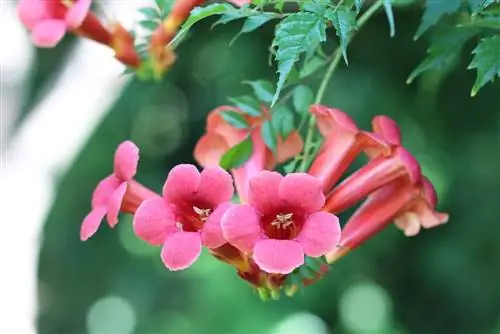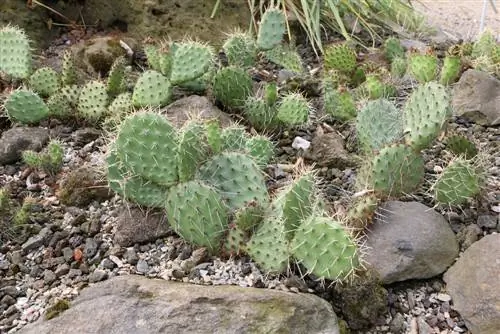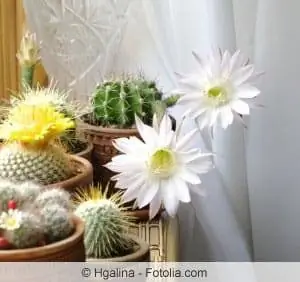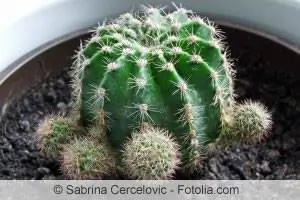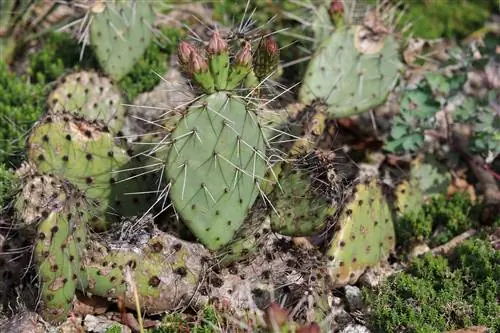- Author admin [email protected].
- Public 2023-12-17 03:39.
- Last modified 2025-01-24 12:45.
Agaves are hardy succulents, but not all agave plants can overwinter outdoors. The great agave Queen Victoria (Agave victoriae-reginae) comes from Mexican desert regions and is considered one of the most resilient agave species. The flowering is a unique experience, with a flower stalk up to five meters high forming. After flowering, an agave dies, but the plant can easily be propagated by kindles (offshoots). Another hardy agave is Agave parryi, which grows up to 30 cm tall. Agaves utahensis, native to Utah (USA), and the large Agave neomexicana are also frost-hardy succulents.
Location and soil
Succulents of winter-hardy varieties can survive severe frost, but rain and moisture can become a problem for them. Many cacti and agaves can hardly tolerate any rain and since our winters are less snowy but more rainy, the cactus plants need a location that is as sheltered from the rain as possible.
Tip:
Cacti don't necessarily have to have a "roof over their head", it's often enough to plant them close to the house wall on the side that gets the least rain.
Another condition is good drainage, because cacti and other succulents can hardly tolerate waterlogging. The plants are well served with a stone bed; the soil should be loose and contain a lot of sand. The “southerners” also enjoy a wind-protected and, of course, sunny location. The sun doesn't necessarily have to shine on the plants all day, but in summer it should be at least. There will be a few sunny hours in the morning and evening. Tip: Cacti and other succulents prefer southern slopes.
Wintering
Preparation of cacti and other succulents for hibernation begins in the autumn months:
- from mid-August there will be no more fertilization,
- from mid-October there will be less or no more watering,
- Weeds continue to be pulled,
- Potted plants are wrapped warmly with fleece or jute.
Tip:
If the plants turn reddish, it is a sign that they are beginning their winter rest.
In winter, succulents do not require any care, and the snow should not be cleared away either, as it serves as a protective layer for the plants.
Care in spring and summer
Depending on the weather, the winter rest is already over in March. During this time, regular care of the hardy succulents begins:
- moderate watering in small portions,
- Fertilize every two weeks,
- From March onwards, plants can be transplanted or repotted,
- weed intensively or use weed fleece,
- Propagate as needed, easiest by cuttings or children.
Diseases and control
Succulents enjoy enviable he alth. Most problems arise from incorrect care, especially a. Insufficient drainage and incorrect substrate, as well as flower fertilizers, cause serious damage and can even lead to the death of the plant. Outdoors, plants can be affected by, for example, spider mites, scale insects and fungal diseases. In addition to chemical products, gardeners recommend using biological products and trying out nettle manure, among other things. If the infestation is severe, the entire plant and soil should be disposed of.
Frequently asked questions
Is it worth bringing hardy succulents into the house (winter garden) for better protection?
No, the plants are prepared for a cold season and need the so-called cold shock.
Can succulents be planted in conventional potting soil?
No, the plants only need cactus soil, otherwise they risk dying.
What you need to know about hardy succulents
Hardy succulents in the rock garden
The low-growing succulents in particular are often used to plant a rock garden. These plants must be hardy, as you usually do not clear a rock garden of plants before winter. Many plants that are considered succulents are not necessarily perceived as such by plant lovers: the stonecrop is an example of hardy succulents that are particularly often used for planting rock gardens. Other hardy succulents that are ideal for the rock garden are the houseleek and the prickly pear.
In addition to the hardy succulents for the rock garden, there is also a very special plant that belongs to the succulent family and that even germinates in frost. The hyacinth is a very popular spring bloomer and is considered a succulent. Your bulb is planted in the ground in October, it germinates in the frost during the winter and blooms in the spring.
Hardy succulents on the terrace
But there are also numerous hardy succulents for patio planting: probably the best-known representative of succulents for patios is the agave. This plant, which can grow both in a rock garden and in a container, comes in more than 200 different species. Some of these species require protection from rain in winter, but all species are hardy.
Hardy perennial succulents
If you prefer hardy succulents in perennial form, you should look for the perennial ice plant. This plant impresses not only with its wonderfully colorful flowers, which only open at midday, but also with its lush growth. Since it is hardy and only requires protection from the rain in some species, the ice plant is ideal for planting in the garden.
Finally, there are also hardy succulents that were not originally intended for overwintering outdoors. Special breeding and hardening right from the start have ensured that even unusual succulents and cacti such as the opuntia have become hardy and can therefore be used very well in the rock garden.


